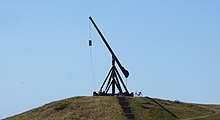Fire basket

A fire basket is an iron basket in which wood can be burned to make a bonfire. Fire baskets have been used since antiquity mainly to illuminate and heat rooms.[1] Today, they are most often used in an outdoor garden area as an outdoor heater or grill. The fire basket primarily is used to contain firewood, or another fuel, and is meant to offer fire protection.[2]
The basket itself consists of a heat-resistant steel, or iron, container with high side walls that are punctuated by large mesh or grid-like openings, with a bowl underneath to catch the ashes.[3]
A fire basket is similar to a brazier, and is often used not only as a heat source but also for cooking or grilling food.
Background
[edit]
During the Middle Ages fire baskets filled with sulfur were used to repel the Black Death.[4]
In addition to its lighting and heating functions, fire baskets have a wide variety of uses. Before document shredders, the fire basket was widely used to burn secret documents, and fire baskets are most often found in a garden for heat and light.[3] The beacon atop the Altenburg castle in Bamberg served to communication with the neighboring Giechburg castle.[3]
Historically, fire baskets were used in lighthouses, such as Skagen's White Lighthouse,[5] as the beacon.[6] In the 16th century, Frederick II ordered the erection of beacons at Skagen, Anholt and Kullen Lighthouse to mark the main route through Danish waters from the North Sea to the Baltic.[7] These "bascule lights" or "tipping lanterns" (Danish: vippefyr) were fire baskets hung from a bascule. In Skagen, the current vippefyr is a reproduction of the original, which dates back to 1626.[8]
Heraldry
[edit]A fire basket is an uncommon heraldic figure in heraldry. Another name in Germany is the "pitch basket",[9] or a "straw basket".[10]
A distinction is made between two representations: Only the empty fire basket or the basket with flames licking up from it is shown in the coat of arms and/or in the upper coat of arms. All heraldic colors are used, but black and the metals are used most often. The flames are mostly red. Deviations and special shapes and positions are to be mentioned in the description of the coat of arms. The town of Becherbach uses the fire basket in its coat of arms from the terms pitch and basket.[11]
A cresset is a fire basket on a pole.[12]
-
Fire basket from the coat of arms of the German community of Becherbach
-
Coat of arms of the Prussian noble family, Proeck
-
Arms of City of Wolverhampton Council with a stalked fire basket in the crest
Gallery
[edit]-
A fire in a basket
-
A fire basket from Pompeii
-
The retired Skagen's White Lighthouse in Skagen, North Judland, Denmark. On the roof is the fire basket once used as a beacon.
See also
[edit]- Family coat of arms of the Proeck family
- Franklin stove
References
[edit]- ^ Guhl, Ernst [in German]; Koner, Wilhelm [in German] (1864). "1. Hälfte: Griechen.". Das leben der Griechen und Römer, nach antiken bildwerken dargestellt [The life of the Greeks and Romans, depicted in ancient paintings] (in German). Berlin: Weidmann. p. 169.
- ^ "Anlegen und Betreiben offener Feuer (gemäß der §§ 2 und 10 der Gefahrenabwehrverordnung der Stadt Halle (Saale))" (PDF). halle.de (in German). Archived from the original (PDF) on September 26, 2020. Retrieved November 21, 2020.
- ^ a b c "So finden Sie die passende Feuerschale für Ihren Garten" [How to find the right fire bowl for your garden]. T-Online (in German). January 28, 2019. Archived from the original on November 7, 2020. Retrieved October 9, 2016.
- ^ "The Rise of Miasma". The Death Scent Project. January 21, 2020.
- ^ "Det Hvide Fyr i Skagen". Den Store Danske (in Danish). November 11, 2011. Retrieved November 9, 2013..
- ^ "Lighthouse Lamps Through Time by Thomas Tag". United States Lighthouse Society. Archived from the original on January 1, 2018. Retrieved May 22, 2023.
- ^ Hahn-Pedersen, Morten (April 2003). "Reports on Baltic Lights – Denmark". In Litwin, Jerzy (ed.). Baltic Sea Identity: Common Sea – Common Culture? (PDF). Gdańsk: Polish Maritime Museum in Gdańsk. p. 81. ISBN 83-919514-0-5.
{{cite book}}: CS1 maint: date and year (link) - ^ Holland, F. Ross (1988) [1972]. America's lighthouses: an illustrated history. New York: Dover. p. 3. ISBN 978-0486255767.
- ^ Gritzner, Maximilian (1888). Großes und allgemeines Wappenbuch (in German). BoD – Books on Demand. p. 131. ISBN 978-3-368-46344-1.
Plate XXVIII Figure 7
- ^ Ernst Heinrich Kneschke (1856). Die Wappen der deutschen freiherrlichen und adeligen Familien in genauer vollständiger und allgemein verständlicher Beschreibung (in German). Vol. 3. Leipzig: T.O. Weigel. p. 363.
- ^ Becherbach municipality’s name
- ^ "Cresset". Victoria and Albert Museum. Retrieved September 5, 2012.
Click "More information" tab
- ^ von Hefner, Otto Titan [in German] (1857). Die Wappen des Württemberger Adels [Coat of arms of the Württemberg nobility]. Nuremberg: Bauer and Raspe. p. 12.
plate 14, image 9
External links
[edit] Media related to Fire baskets at Wikimedia Commons
Media related to Fire baskets at Wikimedia Commons The dictionary definition of fire basket at Wiktionary
The dictionary definition of fire basket at Wiktionary


![Coat of arms of the Prussian noble family, Proeck [de]](http://upload.wikimedia.org/wikipedia/commons/thumb/1/19/Proeck-Wasppen.png/111px-Proeck-Wasppen.png)
![The Württemberg Seuter [ de] carried a golden basket in their escutcheon and upper coat of arms.[13]](http://upload.wikimedia.org/wikipedia/commons/thumb/f/fb/Seutter_von_Letzen_Wappen.jpg/105px-Seutter_von_Letzen_Wappen.jpg)



